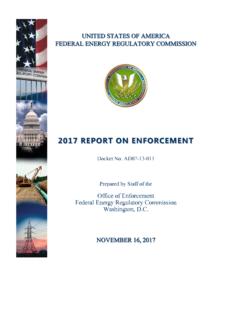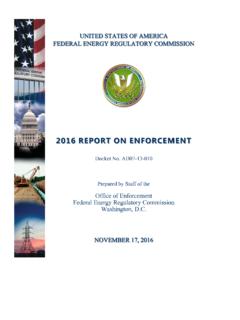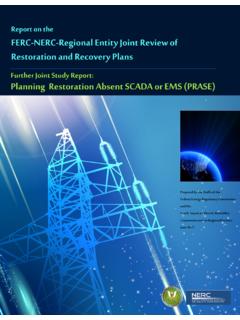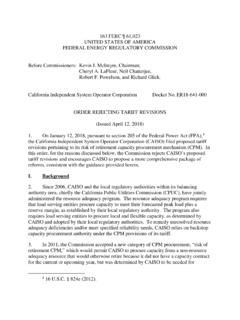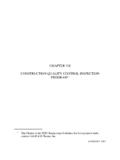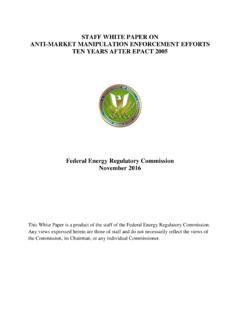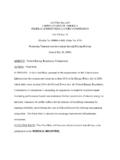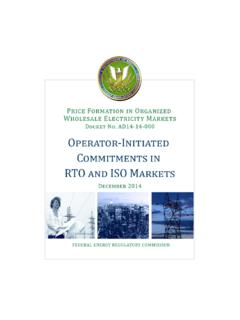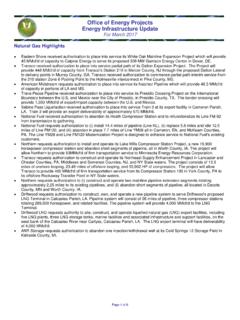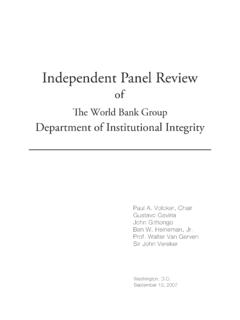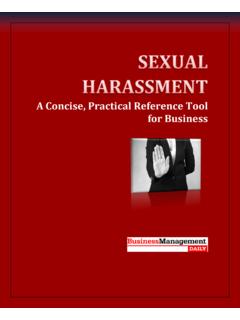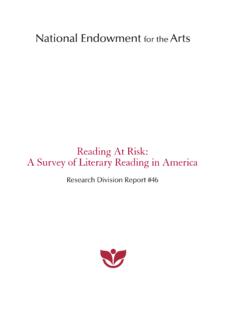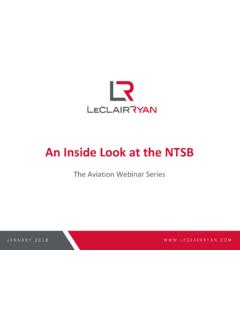Transcription of Federal Energy Regulatory Commission | October …
1 Federal Energy Regulatory Commission | October 2017 1 2017 Transmission Metrics STAFF report Federal Energy Regulatory Commission October 6, 2017 The opinions and views expressed in this staff report do not necessarily represent those of the Federal Energy Regulatory Commission , its Chairman, or individual Commissioners, and are not binding on the Commission . 2 TABLE OF CONTENTS Executive Summary .. 3 Introduction .. 6 I. Metrics to Assess Participation of Nonincumbent Transmission Developers in Regional Transmission Planning Processes .. 8 Percentage of Nonincumbent Transmission Project Bids or Proposals .. 9 Number of Unique Developers Submitting Proposals .. 21 Number and Percentage of Selected Nonincumbent Proposals .. 23 Stakeholder Participation in Regional Transmission Planning Processes.
2 27 II. Metric to Indicate Whether Appropriate Levels of Transmission Infrastructure Exist .. 34 RTO/ISO Market Price Differential .. 34 III. Metrics to Permit Baseline Analyses of the Impacts of Policy Changes .. 42 Load-Weighted Transmission Investment (Incremental) .. 43 Load-Weighted Circuit-Miles (Incremental) .. 47 Load-Weighted Circuit-Miles per Million Dollars of Investment .. 49 IV. Conclusion .. 52 ACKNOWLEDGEMENTS Federal Energy Regulatory Commission Staff Team Rahim Amerkhail Gregory Price Danielle Gordon Jennifer Fletcher Peter Nagler 3 Executive Summary In 2016, Federal Energy Regulatory Commission ( Commission ) staff developed several metrics that assessed transmission investment patterns to inform whether additional Commission action would be necessary to facilitate more efficient or cost-effective transmission development in the United States ( ) that is sufficient to satisfy the nation s transmission needs.
3 Commission staff published its initial report (2016 report ),1 with the analysis and findings, in March 2016 and presented the results at the April 2016 Commission meeting. In this report (2017 report ), staff presents updated results for all but one2 of the metrics included in the 2016 report , as well as initial results for several new metrics. Like the 2016 report , this iteration explains the data and methods that staff used to calculate each metric. Then, the report presents the results for each metric and staff s inferences based on the calculated metrics. When discussing the metrics to assess the participation of nonincumbent transmission developers in the regional transmission planning processes, the 2017 report focuses on only those transmission planning regions that have conducted at least one competitive proposal To date, these include only five transmission planning regions, all of which are RTOs/ISOs.
4 With the exception of the RTO/ISO market price differential metric, all of the other metrics include data from all transmission planning regions. 1 See Transmission Metrics: Initial Results, AD15-12 -000, Federal Energy Regulatory Commission (March 2016), -16 2 The metric on load-weighted curtailment frequency was not included in the 2017 report , and the reason for this omission is discussed below. 3 For convenience, we use the term proposal window to represent the opportunity that a transmission planning region provides for transmission developers to submit proposals in response to transmission needs or to be selected to use the regional cost allocation method for a specific transmission project. 4 Key new findings in the 2017 report include: Transmission Investment Metrics Metric New Findings in the 2017 report Metrics to Assess Participation of Nonincumbent Transmission Developers in Regional Transmission Planning Processes Percentage of Nonincumbent4 Transmission Project Bids or Proposals PJM Interconnection, (PJM) held five new competitive proposal windows in 2015 and 2016, with nonincumbents submitting 46 percent of the proposals received between 2013 and 2016.
5 For its first two proposal windows, New York Independent System Operator (NYISO) received more proposals from nonincumbents than incumbents in 2015, but the reverse was true in 2016. Nonincumbents submitted the majority of proposals in response to Midcontinent Independent System Operator s (MISO) first proposal window in 2016. Number of Unique Developers5 Submitting Proposals (New Metric for 2017 report ) The number of unique developers submitting proposals in PJM was comparatively low compared to the total number of proposals received. In California Independent System Operator (CAISO), NYISO, and MISO, unique developers submitted roughly one proposal each. Number and Percentage of Selected Nonincumbent Proposals (New Metric for 2017 report ) For all of the transmission planning regions that had competitive proposal windows, the percentage of selected proposals that nonincumbents submitted declined from 20 percent in 2013, to 6 percent in 2014, to 3 percent in 2015, and to zero in 2016.
6 CAISO had the largest increase in nonincumbents share of selected proposals between 2013 and 2015. 4 Order No. 1000 defines a nonincumbent transmission developer as either: (1) a transmission developer that does not have a retail distribution service territory or footprint; or (2) a public utility transmission provider that proposes a transmission project outside of its existing retail distribution service territory or footprint, where it is not the incumbent for purposes of that project. By contrast, an incumbent transmission developer/provider is defined as an entity that develops a transmission project within its own retail distribution service territory or footprint. See Transmission Planning and Cost Allocation by Transmission Owning and Operating Public Utilities, Order No.
7 1000, FERC Stats. & Regs. 31,323 at P 225 (2011), order on reh g, Order No. 1000-A, 139 FERC 61,132, order on reh g and clarification, Order No. 1000-B, 141 FERC 61,044 (2012), aff d sub nom. Pub. Serv. Auth. v. FERC, 762 41 ( Cir. 2014). 5 A unique developer is defined as an entity that is distinct from other transmission developers in terms of the proposals submitted to a transmission planning region in a given year. In instances where a transmission developer submits multiple proposals in a given year, staff considers that transmission developer only once for that year. A unique developer can include an incumbent transmission developer, a nonincumbent transmission developer, a consortium (where a group of transmission developers operates as a separate legal entity), or a joint venture where two or more legal entities (either incumbent or nonincumbent) work together to develop a proposal while maintaining their own legal status.
8 Furthermore, a given transmission developer that submits proposals independently is considered distinct from a consortium or joint venture in which that entity is involved. The purpose of this metric is to determine how many distinct developers are submitting proposals ( , Are a few transmission developers submitting most of the proposals in a given transmission planning region or are many different transmission developers submitting proposals?). Chart continued next page 5 PJM selected the largest number of proposals overall compared to other transmission planning regions, but it selected only one nonincumbent proposal over four years. Southwest Power Pool (SPP) and MISO each selected an incumbent proposal in their single proposal windows in 2015 and 2016, respectively. Stakeholder Participation in Regional Transmission Planning Processes (New Metric for 2017 report ) Stakeholder attendance at regional transmission planning process meetings during fiscal year 2015 (FY 2015) and fiscal year 2016 (FY 2016) was relatively stable in both RTOs and non-RTOs.
9 Nonincumbents are participating in stakeholder meetings in most transmission planning regions, with their participation increasing in four of the 12 regions. Metric to Indicate Whether Appropriate Levels of Transmission Infrastructure Exist RTO/ISO Market Price Differential Relatively high or low real-time locational marginal prices (LMPs) occurred persistently ( , for at least two years) at 1,482 generator or load points since 2005, a decline from 1,986 points in the 2016 report . Many of the high-priced points and low-priced points disappeared in SPP. Metrics to Permit Baseline Analyses of the Impacts of Policy Changes Load-weighted Transmission Investment (Incremental) Load-weighted transmission investment averaged $ per megawatt hour (MWh) of retail load for all North American Electric Reliability Corporation (NERC) regions between 2008 and 2015, up from a load weighted average of $ per MWh of retail load between 2008 and 2014 in the 2016 report .
10 Load-weighted Circuit-Miles (Incremental) Load-weighted circuit-miles remained unchanged from the 2016 report at circuit-miles per terawatt hour (TWh) across all NERC regions between 2008 and 2015. Load-Weighted Circuit-Miles per Million Dollars of Investment (Incremental)6 The average load-weighted circuit-miles per million dollars of investment decreased slightly between the 2016 report and the 2017 report by load-weighted circuit-miles per million dollars of transmission investment for all NERC regions. Midwest Reliability Organization (MRO) fell from the NERC region with the highest load-weighted circuit-miles per million dollars of investment in the 2016 report to the region with the sixth highest load-weighted circuit-miles per million dollars of investment in the 2017 report . 6 The metric addressing load-weighted circuit-miles per million dollars of investment (incremental) aims to provide a basis for assessing the cost impact of different policy choices or factual circumstances on transmission investment.
